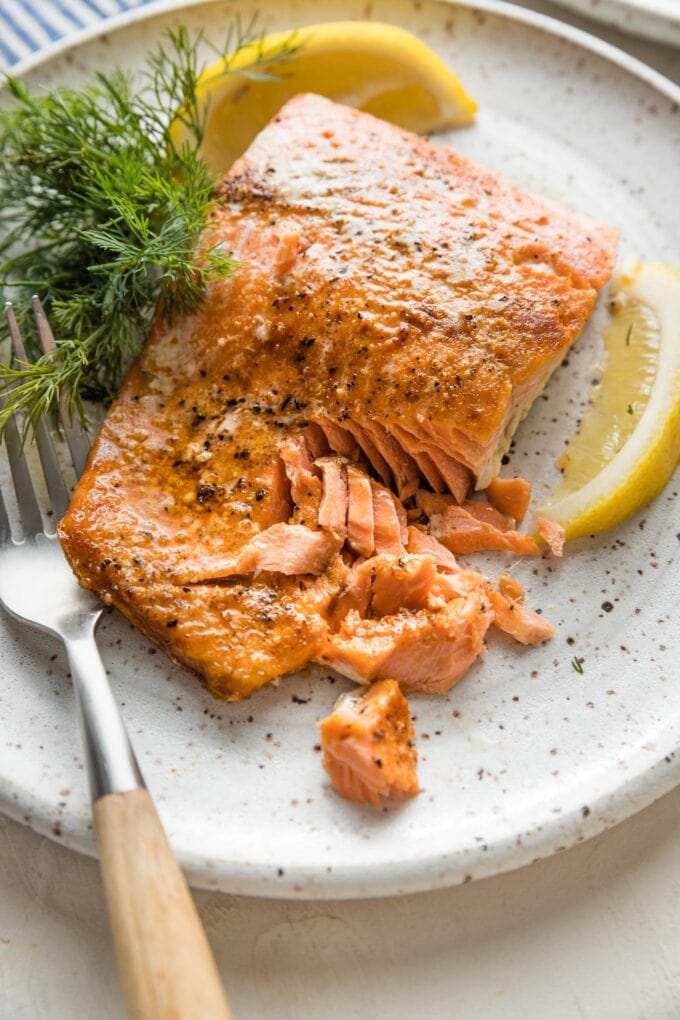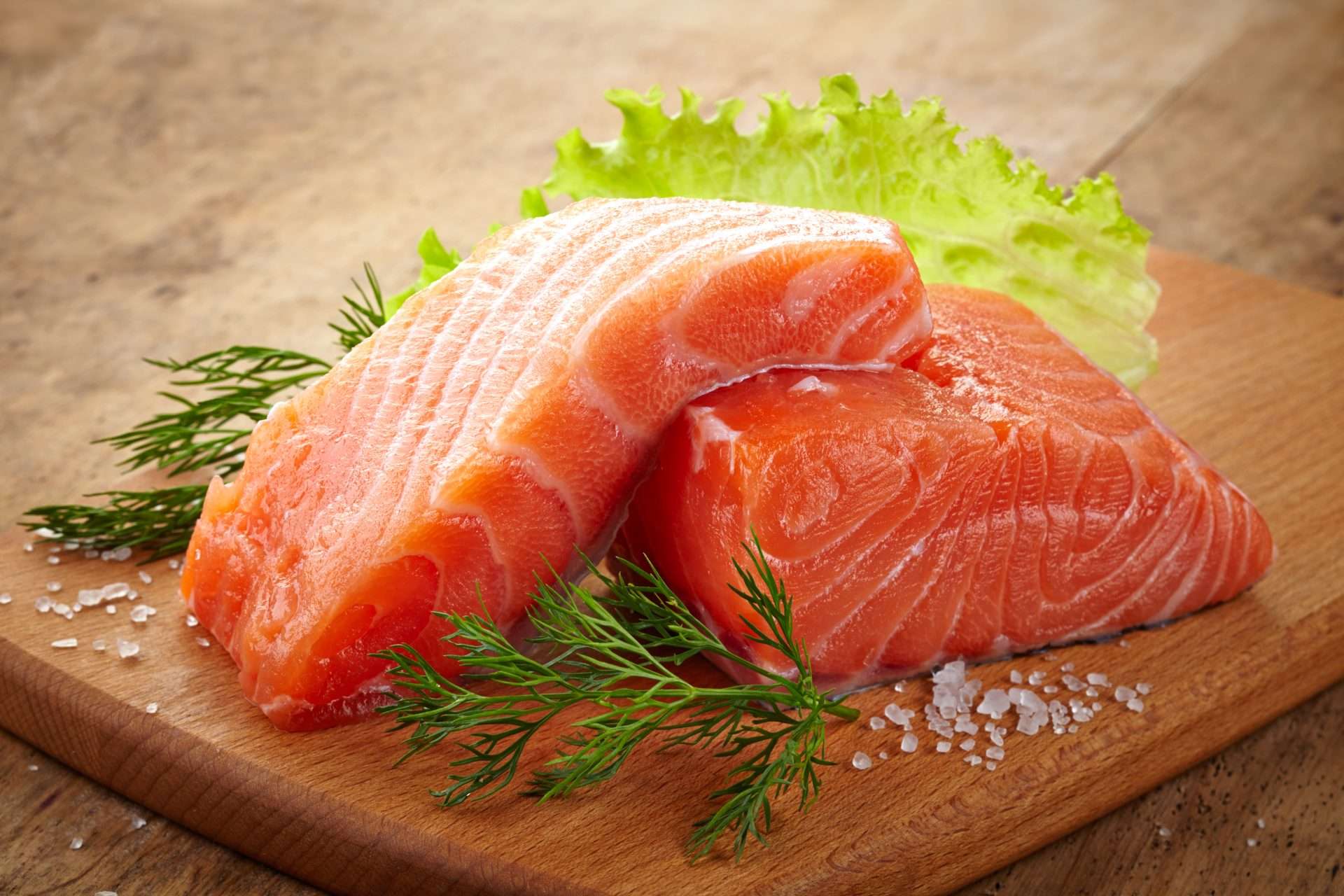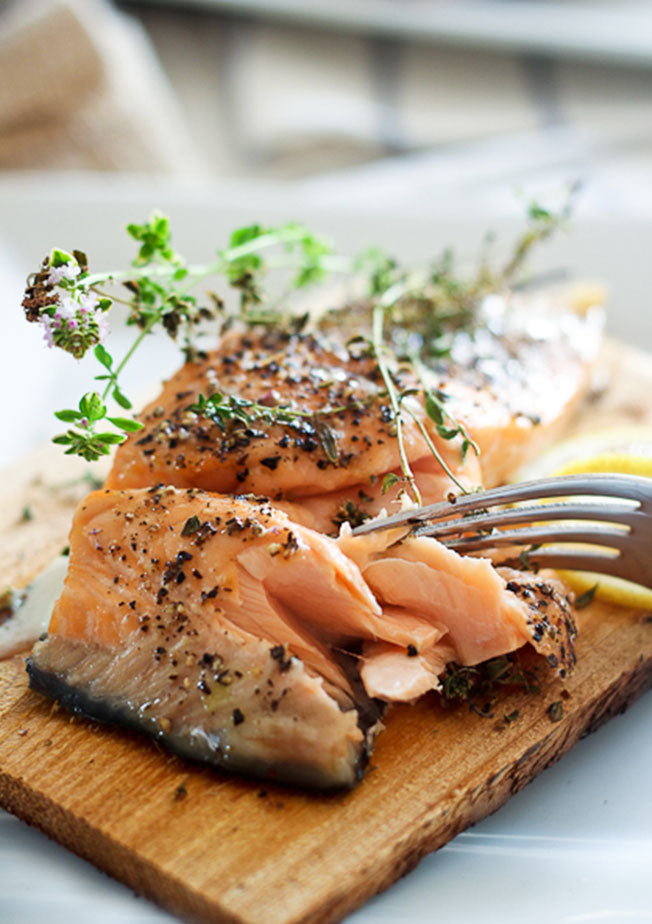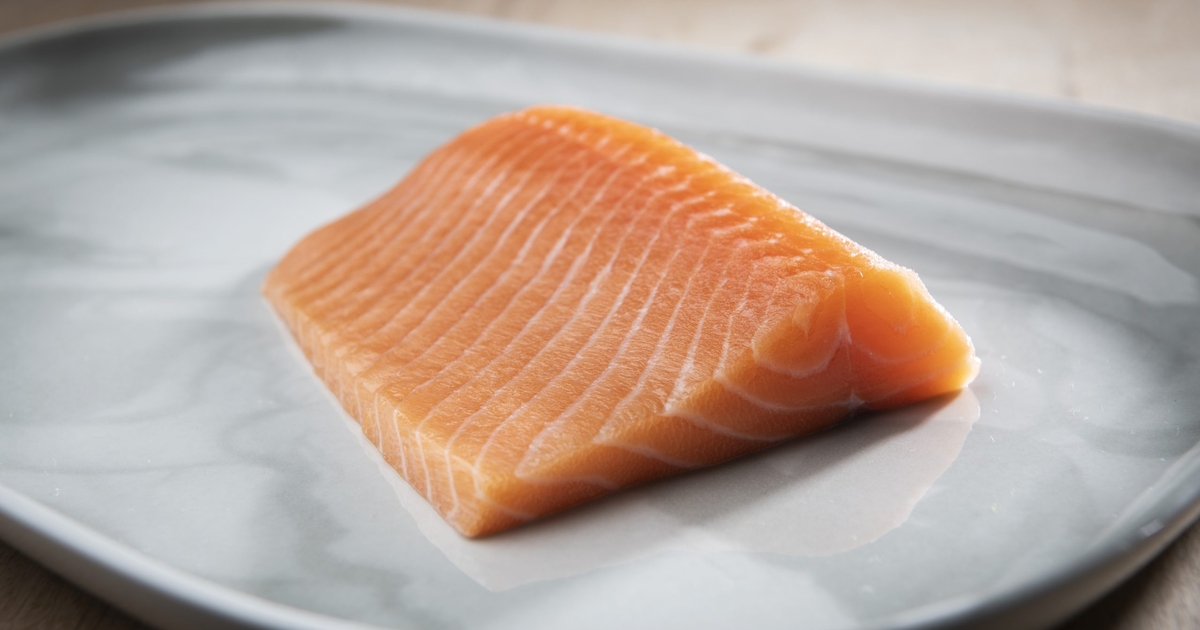Introduction

Cooked salmon color is not just a visual feast, but also an indicator of its quality and doneness. Understanding the complexities of color changes in cooked salmon is essential for both culinary enthusiasts and professionals. This article aims to unravel the different factors that contribute to the transformation of salmon’s color during cooking. From the chemical processes at play to the influence of heat on pigments, we will delve into the science behind this fascinating phenomenon. Additionally, we will explore the spectrum of pink and orange hues that can be observed in cooked salmon and discuss common color abnormalities. By understanding these factors, we can not only appreciate the beauty of cooked salmon, but also ensure that it is cooked to perfection.
Understanding The Importance Of Cooked Salmon Color
The color of cooked salmon holds significant importance for both culinary enthusiasts and professionals. It serves as a visual indicator of the quality and doneness of the fish. A vibrant and evenly colored salmon signifies that it has been cooked properly, ensuring optimal flavor and texture. On the other hand, deviations in color can indicate undercooking or overcooking, leading to a less enjoyable dining experience. By understanding and appreciating the nuances of cooked salmon color, individuals can ensure that they are serving a delicious and perfectly cooked dish. [1]
Factors Affecting The Color Change In Cooked Salmon
There are several factors that can influence the color change in cooked salmon.
- Species and origin: Different species of salmon have different natural pigments, which can result in variations in color. Additionally, the environment and diet of the salmon can also impact the color.
- Cooking methods and temperatures: The cooking method and temperature can affect the color change in salmon. Overcooking can cause the salmon to become dry and turn a lighter shade, while undercooking can leave the salmon with a raw, translucent appearance.
- pH levels: The pH levels in the cooking environment can also influence the color of the salmon. Higher acidity levels can result in a lighter color, while lower acidity levels can lead to a darker color.
- Oxidation: Exposure to air during cooking can cause oxidation, resulting in a change in color. This oxidation can lead to browning or graying of the salmon.
By being aware of these factors, individuals can better understand and control the color change in their cooked salmon.
How Does Salmon Change Color When Cooked?

When salmon is cooked, it undergoes a chemical transformation that causes its color to change. The main reason behind this color change is the impact of heat on the pigments present in the salmon flesh. These pigments, known as carotenoids, are responsible for the characteristic pink or orange color of the fish. As the heat is applied, the carotenoid pigments break down and release their color, resulting in the vibrant pink or orange hues that we associate with cooked salmon. The precise color achieved can vary depending on factors such as the species and origin of the salmon, as well as the cooking method and temperature used.
Chemical Processes In Cooked Salmon
When salmon is cooked, there are various chemical processes that occur within the fish’s flesh. One of the key processes is the denaturation of proteins, which causes the firming and coagulation of the salmon’s texture. Additionally, the heat applied during cooking causes the breakdown of carotenoid pigments, such as astaxanthin, which are responsible for the vibrant pink or orange color of the fish. As these pigments break down, they release their color, resulting in the beautiful hues observed in cooked salmon. These chemical reactions contribute to the transformation of raw salmon into a visually appealing and delectable dish.
Impact Of Heat On Pigments In Salmon Flesh
The pigments in salmon flesh, such as astaxanthin, are highly sensitive to heat. When salmon is cooked, the application of heat causes these pigments to break down. As a result, the vibrant pink or orange color of the salmon may fade or change. The temperature and cooking time play a significant role in determining the extent of color change. Overcooking salmon can lead to a loss of pigmentation and a duller appearance. Therefore, it is crucial to carefully control the cooking process to maintain the desired color and visual appeal of cooked salmon.
Pink To Orange: Exploring The Color Spectrum In Cooked Salmon

Cooked salmon showcases a vibrant range of colors, from delicate pink to rich orange tones. The variation in color is influenced by several factors, including the species of salmon and its diet. Pink salmon tends to have a lighter pink hue, while sockeye salmon is known for its intense orange color. The presence of carotenoid pigments, such as astaxanthin, contributes to the striking hues seen in cooked salmon. These pigments are derived from the salmon’s diet, which often consists of krill and other small crustaceans. The more astaxanthin present in the salmon’s diet, the deeper the orange color will be. So, the color spectrum in cooked salmon offers a visually captivating experience for seafood enthusiasts.
The Different Shades Of Pink And Orange In Cooked Salmon
The color spectrum of cooked salmon ranges from delicate pink to rich orange hues. The exact shade depends on the species of salmon and its diet. Pink salmon tends to display a lighter pink color, while sockeye salmon is known for its intense orange hue. This variation in color is attributed to the presence of carotenoid pigments like astaxanthin. The more astaxanthin present in the salmon’s diet, derived from consuming krill and small crustaceans, the deeper the orange color will be. The stunning range of colors adds visual appeal to cooked salmon dishes.
The Role Of Carotenoids In Color Transformation
Carotenoids play a crucial role in the color transformation of cooked salmon. These pigments, such as astaxanthin, are naturally present in the diet of the fish, primarily from the consumption of shrimp and krill. During the cooking process, the carotenoids undergo chemical changes, resulting in the vibrant shades of pink and orange seen in cooked salmon. The level and type of carotenoids present in the fish’s flesh determine the intensity of the color. The presence of carotenoids not only enhances the visual appeal of cooked salmon but also provides important health benefits, as they are antioxidants known for their potential anti-inflammatory properties.
Common Color Abnormalities In Cooked Salmon

Common color abnormalities in cooked salmon can occur due to various factors. One common abnormality is gray or brown discoloration, which can indicate overcooking or improper storage. This can affect the visual appeal of the salmon dish. Another abnormality is a green or blue tinge, which can occur when the fish is not handled properly during processing or when certain bacteria are present. These color abnormalities may impact the perceived freshness and quality of the cooked salmon. To ensure optimal color and appearance, it is important to properly handle, store, and cook the salmon.
Gray Or Brown Discoloration In Cooked Salmon
Gray or brown discoloration in cooked salmon can occur due to overcooking or improper storage. When salmon is cooked for too long or at high temperatures, it can result in a gray or brownish color. Additionally, if the salmon is not stored properly or exposed to air, it can develop discoloration. This gray or brown tinge may affect the visual appeal of the dish and can indicate that the salmon is not fresh. To prevent discoloration, it is important to cook salmon for the appropriate amount of time and store it properly to maintain its vibrant color and freshness.
Green Or Blue Tinge In Cooked Salmon
Green or blue tinge in cooked salmon can occur due to bacterial growth or contamination. When salmon is exposed to bacteria, such as Pseudomonas fluorescens, it can result in a green or blue discoloration. This can happen when the salmon is not stored properly or when it is past its expiration date. The presence of this tinge indicates that the salmon is no longer safe to consume. It is important to ensure proper storage and handle salmon with food safety guidelines to avoid contamination and maintain its fresh and safe quality.
Factors Influencing Cooked Salmon Color

The color of cooked salmon can be influenced by various factors. One important factor is the species and origin of the salmon. Different species of salmon can have different natural pigments in their flesh, leading to variations in color. Additionally, the diet of the salmon can also impact its color. For example, salmon that feed on krill or shrimp tend to have a more vibrant pink or orange color. Furthermore, the cooking method and temperature can affect the color of the salmon. Overcooking can cause the salmon to become pale and lose its vibrant color. It is essential to consider these factors when preparing and cooking salmon to achieve the desired color and visual appeal. [24]
Species And Origin Of The Salmon
The species and origin of the salmon are significant factors that contribute to the cooked salmon’s color. Different species of salmon have varying natural pigments in their flesh, resulting in variations in color. For example, wild-caught salmon tends to have a more vibrant color compared to farm-raised salmon. Additionally, the geographical location where the salmon is harvested can also impact its color. Salmon from colder waters may have a deeper red or orange hue compared to those from warmer waters. It is important to consider the species and origin of the salmon when aiming for a specific cooked salmon color. [25]
Cooking Methods And Temperatures
Cooking methods and temperatures play a significant role in the color of cooked salmon. The cooking method and temperature determine the extent to which the natural pigments in the salmon flesh are retained or altered. Different cooking methods, such as grilling, baking, or poaching, yield different results in terms of color. Higher cooking temperatures can cause the pigments to break down faster, resulting in a lighter or less vibrant color. It is important to choose the appropriate cooking method and temperature to achieve the desired cooked salmon color. Experimenting with different techniques can help determine the best approach to showcase the vibrant hues of salmon.
Tips For Maintaining Desirable Cooked Salmon Color

To maintain a desirable cooked salmon color, there are a few tips to keep in mind.
- Don’t overcook: Overcooking salmon can lead to a loss of color and result in a dry and less appetizing appearance. Cook the salmon just until it reaches the desired doneness and flakes easily with a fork.
- Use low and slow cooking methods: Slow-cooking methods like baking or poaching at lower temperatures help preserve the natural color of the salmon. This allows the flesh to cook gently and retain its vibrant hue.
- Avoid acidic marinades: Acidic marinades can break down the pigments in salmon, resulting in a lighter color. Opt for marinades with neutral or mild flavors to maintain the desired color.
- Serve immediately: Cooked salmon tends to lose its vibrant color over time. Serve the salmon immediately after cooking to showcase its best color and freshness.
By following these tips, you can ensure that your cooked salmon remains visually appealing and appetizing.
Best Practices For Preserving Salmon Color
To preserve the vibrant color of cooked salmon, there are a few best practices to follow. Firstly, avoid overcooking the salmon as it can result in a loss of color and a less appealing appearance. Use low and slow cooking methods such as baking or poaching at lower temperatures to maintain the natural color of the salmon. Additionally, opt for neutral or mild-flavored marinades to avoid breaking down the pigments in the salmon. Finally, serve the cooked salmon immediately after cooking to showcase its best color and freshness. By following these practices, you can ensure that your salmon remains visually appealing.
Enhancing The Presentation Of Cooked Salmon Dishes
When it comes to enhancing the presentation of cooked salmon dishes, attention to detail can make a big difference. Here are some tips to make your salmon dishes visually appealing:
- Garnish with fresh herbs: Sprinkle some finely chopped dill, parsley, or chives on top of the cooked salmon to add a pop of green color and freshness.
- Add vibrant vegetables: Serve the salmon alongside colorful roasted or steamed vegetables such as asparagus, bell peppers, or cherry tomatoes to create a visually appealing plate.
- Plate creatively: Arrange the salmon slices in an elegant manner, overlapping them slightly. Use a circular or rectangular plate to showcase the beauty of the salmon.
- Drizzle with sauce: Finish the dish by drizzling a flavorful sauce like lemon butter or dill sauce over the salmon. This not only adds flavor but also creates an enticing visual effect.
Remember, presentation plays a crucial role in making your cooked salmon dishes even more tempting and appetizing.
FAQ: Cooked Salmon Color
Q: What is the color of properly cooked salmon?
A: Properly cooked salmon should have a vibrant pink or coral color. The flesh should appear opaque and easily flake with a fork.
Q: Why does salmon turn pink when cooked?
A: The characteristic pink color of cooked salmon comes from pigments called carotenoids, which are naturally present in the fish. These pigments are released and become more pronounced as the salmon is cooked.
Q: Can the color of cooked salmon vary?
A: Yes, the color of cooked salmon can vary depending on several factors, including the species of salmon, diet, and preparation method. For example, sockeye salmon tends to have a deeper red color, while other varieties may appear more pink or orange.
Q: What should I do if my cooked salmon has a dull color?
A: If your cooked salmon appears dull or grayish, it could mean that it was overcooked or improperly stored before cooking. Overcooking can cause the pigments to break down and lose their vibrant color. To avoid this, make sure to cook salmon just until it reaches the desired doneness and store it properly in the refrigerator before preparation.
Q: Can cooked salmon ever appear white?
A: In some instances, cooked salmon may appear white. This can happen when the fish is cooked very gently or poached at a lower temperature. While the color may not be as visually appealing, the salmon is still safe to eat as long as it has reached the appropriate internal temperature.
Q: Are there any health concerns related to cooked salmon color?
A: Generally, the color of cooked salmon is not an indication of its safety or freshness. However, if the salmon exhibits an unnatural color (e.g., grayish-green or an intense artificial pink), it may be a sign of spoilage or potentially harmful additives. In such cases, it is best to avoid consuming it and seek a fresh alternative.
Q: How can I ensure that my salmon is properly cooked?
A: The best way to ensure your salmon is properly cooked is to use a food thermometer. The internal temperature of cooked salmon should reach a minimum of 145°F (63°C). At this temperature, the fish should be opaque, moist, and flake easily.
In conclusion, the color of properly cooked salmon is typically a vibrant pink or coral. However, variations in color can occur due to factors such as species, diet, and cooking method. Remember to cook salmon just until it reaches the desired doneness and check the internal temperature to ensure it is cooked thoroughly. Enjoy your perfectly cooked salmon!

A small, independently run fish and chip shop using quality ingredients cooked freshly in our kitchen to ensure great tasting food. All of our drinks are in glass bottles, and all of our takeaway packaging is recyclable or compostable to help reduce our impact on the environment.